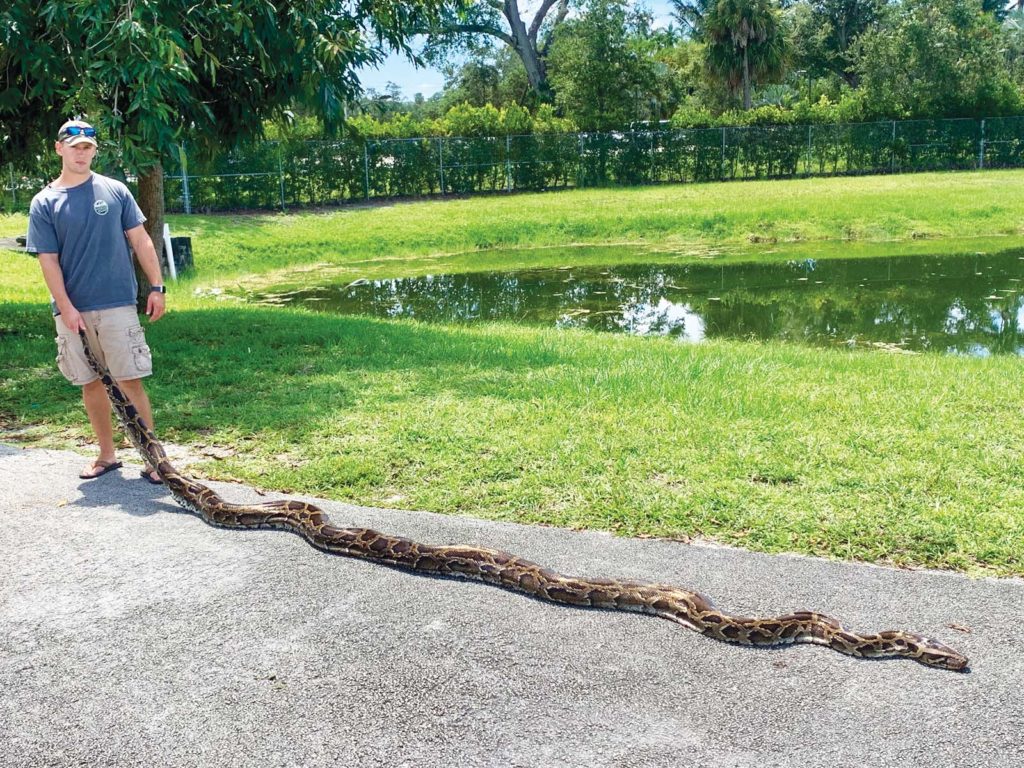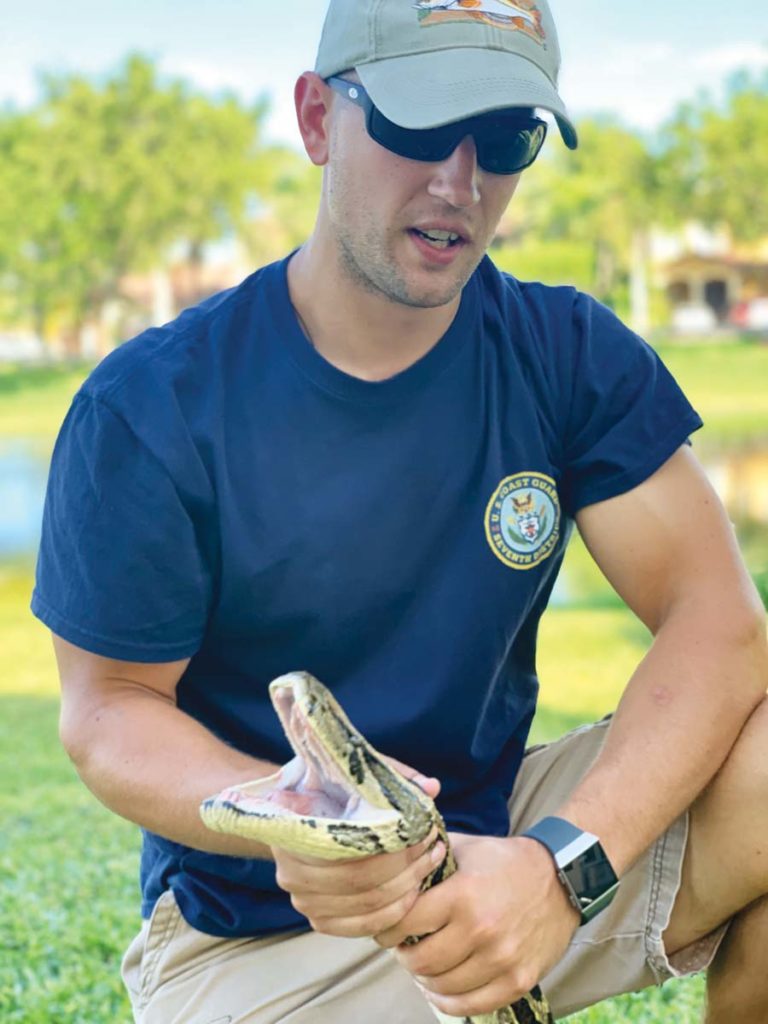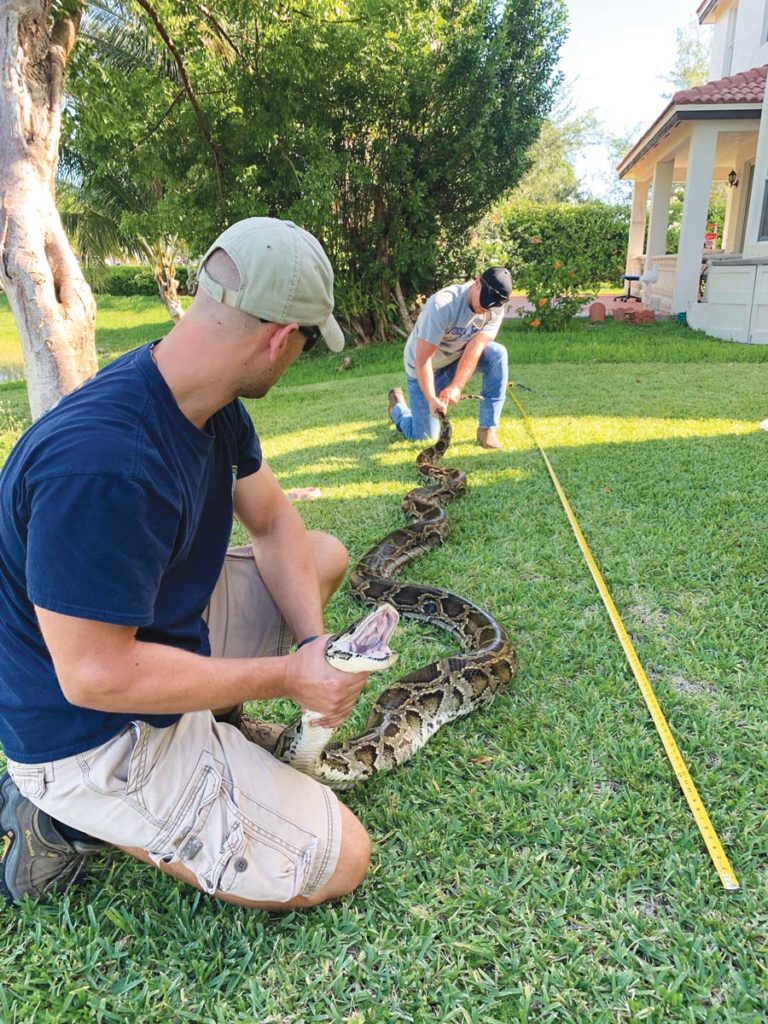Did you know Florida’s Burmese python problem is spreading north? Former Cory Lakes Isles resident and Wharton High grad Kevin Reich is helping to make sure that doesn’t happen.

Kevin Reich was driving through the Grand Cypress National Preserve in Ochopee, FL, one evening back in late July, and was about to give up and head home when the tail of a Burmese python caught his eye.
“Just by the tail, I knew it was going to be a big one,” Kevin says.
So, he did exactly the opposite of what you might expect — but something perfectly normal for him — he parked his car on the side of the road, hopped out and walked up to the snake.
Armed only with his bare hands, Kevin grabbed the tail and dragged the python out, the two dancing a slithery dance, as he deftly avoided attempts by the python, which are non-venomous constricting snakes, to wrap itself around him.
After 15 minutes, the snake was tuckered out. Kevin grabbed it by the neck and victoriously bagged it.
He was right about the size, too: it checked in at a goosebump-inducing 17-feet, 9 inches long, and weighed in at 83 pounds, 12 ounces.
At the time, it was the second-longest ever caught by a member of the Python Action Team.
“I knew it was going to be a challenge and a bit of a battle,” Kevin says. “Big snakes don’t come along much. It was a very big, very strong animal. When it started to lose its steam, I just went in for its head and got a hold of it. I could tell it was still very strong. It was trying to turn its jaw around to bite me. The hardest thing sometimes is getting them in the bag.”

While Kevin’s full-time job is in the U.S. Coast Guard, he finds plenty of time to do his part to help the Florida Fish and Wildlife Conservation Commission (FWC) try to tame the ever-growing population of Burmese pythons in the Florida Everglades and surrounding areas. The FWC created the Python Action Team in 2017, to combat the invasive species, and has captured nearly 1,000 pythons since.
Still, Kevin says that in certain areas, where racoons, rabbits and opossums should be bountiful, there too often is nothing, due to the spread of the Burmese python.
He says he knows what animals do and don’t belong in a certain area. Growing up in Cory Lake Isles, he says he was your typical Florida outdoor boy, exploring his nature-rich community.
“There isn’t one little portion of those lakes or islands that I don’t know,” he says. “I fished on that lake every day. It’s where I learned a lot about the outdoors in Florida.”
Kevin joined the Coast Guard in 2016, after graduating from Wharton in 2012.
He was stationed in Miami, which was a perfect fit, in part because it allowed him to explore the Everglades. It was while doing so with a buddy that he caught his first Burmese python — a freshly hatched 2-footer.
By the way, his second catch was a 15-and-a-half foot python.

He became a certified volunteer Burmese python hunter, before the FWC and Southwest Water Management District began programs that contracted people to help rid the area of pythons.
“It’s awesome,” Kevin says. “You get paid to go out in these places in the Everglades and explore and help remove these snakes.”
Python Action Team members make just $8.46 an hour, plus $50 for each snake measuring 4 feet, and $25 for each additional foot beyond that. So, a 17-foot Burmese python would net the hunter $375.
That’s a nice bonus for something Kevin confesses he would do for free just to help. He says that 95 percent of contractors do not euthanize pythons on site. Instead, they bag them and hand them over to the FWC for research, as the wildlife commission tries to figure out a way to more effectively remove the snakes.
Since he began trapping pythons, Kevin says he has captured well over 100 of them. He has been bitten numerous times, and has been sprayed with the snake’s musk, which he says leaves one the foulest odors he has ever smelled. He says he keeps Lysol disinfectant wipes in his equipment bag to wipe off his arms anytime he gets tagged.
The longest python ever caught in Florida was 18-feet, 8-inches (in 2013), and the longest ones caught by the Python Action Team are 18’-4” (in September) and 18’ (last December).
“Most of the folks that know me are not at all surprised that I do this,” Kevin says. “It’s definitely a challenge and something I enjoy. I know what animals do and don’t belong, and some of these places just don’t have any small mammals or birds left. These snakes are everywhere. I’m doing my part to help and preserve the area.”




No comment yet, add your voice below!